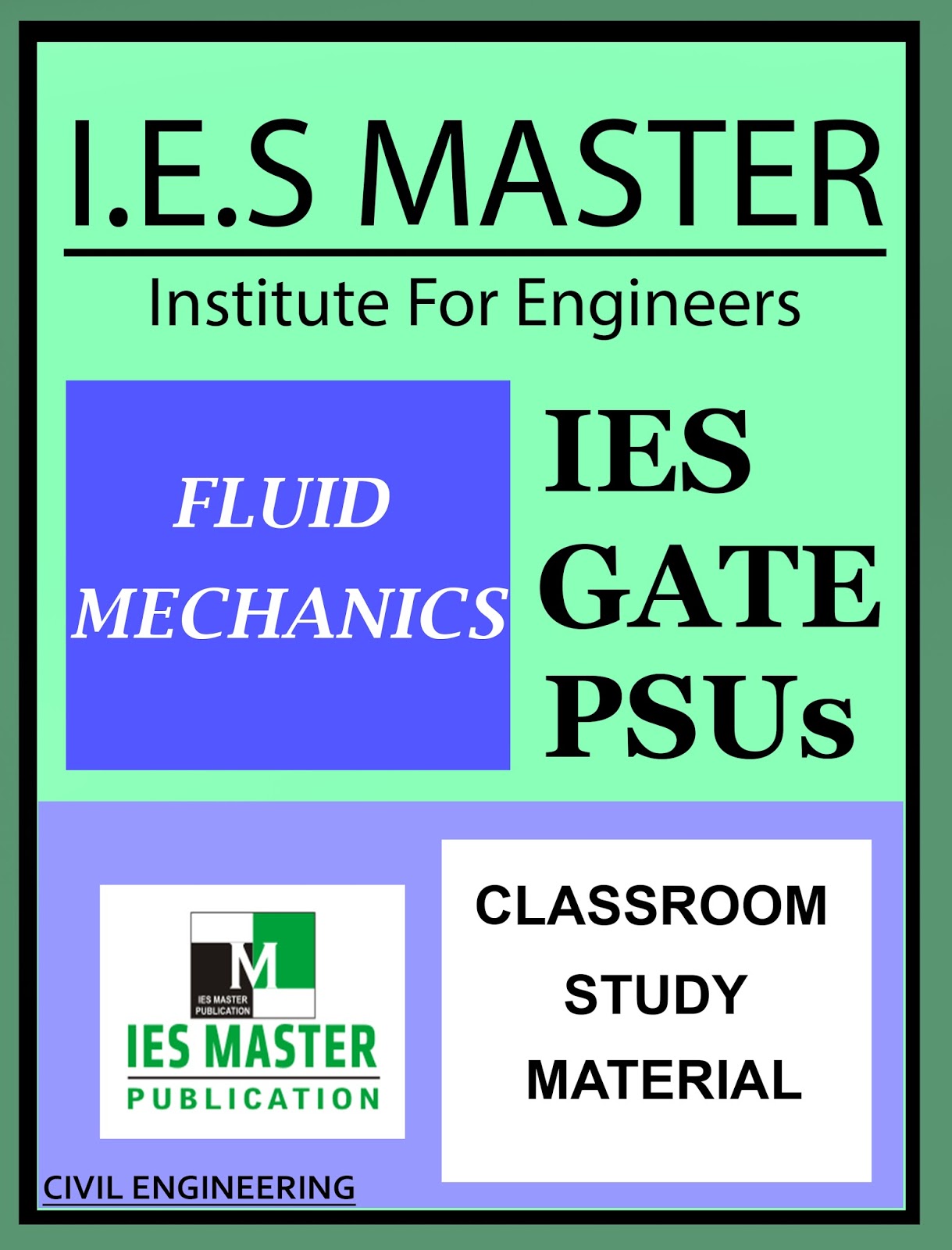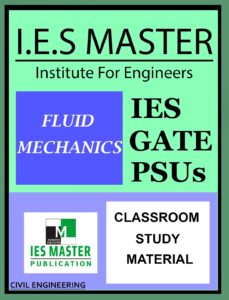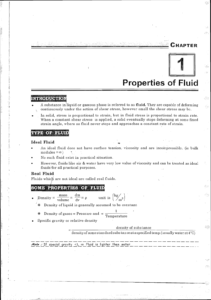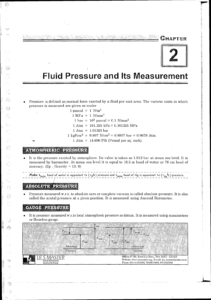
IES MASTER GATE MATERIAL
FLUID MECHANICS
GATE – PSU – IES – GOVT EXAMS – STUDY MATERIAL
FREE DOWNLOAD PDF


ABOUT THE BOOK :
IES MASTER’S GATE MATERIAL IS USEFUL FOR NOT ONLY GATE ASPIRANTS BUT ALSO IES, PSU JOBS, GOVERNMENT JOBS AND MANY COMPETITIVE EXAMS. IES MASTERS IS ONE OF THE TOP MOST GATE COACHING INSTITUTES IN INDIA. A MUST HAVE BOOK FOR MAINLY GATE PREPARING CIVILIANS.
CONTENTS :
- Properties of Fluids
- Fluid Pressure and Measurements
- Hydrostatic Forces
- Buoyancy and Floatation
- Liquid in Relative Equilibrium
- Fluid Kinematics
- Fluid Dynamics
- Momentum Equations and Applications
- Orifice/Mouthpiece/Notches/Weirs
- Laminar Flow
- Turbulent Flow
- Boundary Layer
- Drag and Lift
- Dimensional Analysis
- Pipe Flow
Properties of Fluids
INTRODUCTION : A substance in liquid or gaseous phase is referred to as fluid. They are capable of def continuously under the action of shear stress, however small the shear stress may In solid, stress is proportional to strain, but in fluid stress is proportional to strain When a constant shear stress is applied, a solid eventually stops deforming at some strain angle, where as fluid never stops and approaches a constant rate of strain.
TYPE OF FLUID – Ideal Fluid : An ideal fluid does not have surface tension, viscosity and are incompressible. (i modules oo No such fluid exist in practical situation. However, fluids like air& water have very low value of viscosity and can be treated as fluids for all practical purposes. Real Fluid Fluids which are not ideal are called real fluids.
VAPOUR PRESSURE AND CAVITATION At a liquid-air interface, a continuous exchange of molecules takes place. The liquids evaporate because the liquid molecules escape from the surface into a gaseous form, called the vapour these vapour molecules exert a partial pressure in the space, known as the vapour pressure When the pressure above a liquid becomes less than or equal to the vapour pressure, boil starts. This property of liquids, in fact,may cause an undesirable effect called the cavitation. In ma liquid flow situations, it is possible that very low pressures are produced at certain location for example, in figure shown below the pressure at point A may drop to a very low value a may become equal to the vapour pressure of water. When this occurs, water starts boiling point A. Thus a rapidly expanding vapour pocket called cavity because they lead to form in the liquid flow) is formed drag of in none is normally swept away from the point A
A rapidly expanding vapour pocket called cavity because they lead to cavity forma he liquid flow) is formed. Because of the flow, this pocket vapour is usually swept away from the point A where it originated to a point B of high pressure use of the high pressure at B, the cavity collapses(or, the bubbles burst). This pro formation& collapsing of cavity is called cavitation generates annoying and noise and causes damage to equipment because erosion surface pitting and fatigue failure] our pressure increases with temperature. Hence at higher temperature, chance is more there is greater chance that pressure in may our pressure with high vapour pressure evaporates readily and are known as volatile liquid mercury has very low vapour pressure. Hence it can be used in pressure measurements so that it can measure even low pressures without evaporating.
SURFACE TENSION AND CAPILLARY EFFECT
SURFACE TENSION AND CAPILLARY : At the interface of liquid and a gas, molecule or between two immisciable liquid a film or special layer seems to form apparently owing to the attraction of liquid molecule on surface from below the surface. As a result of net down ward force, surface will be pulled down causing a curvature to the surface. This in turn develops a tension in the surface which is similar to the tension in a stretched membrane. This is known as surface tension. It is force per unit length with unit of N1 m. As the surface tension is primarily due to cohesion, as temperature increases, surface tension decreases. Effect of pressure on surface tension is negligible.

HYDROSTATIC FORCES
In many engineering problem we need to calculate on plane and forces curved surfaces. For example, forces on walls of container on the gates in the spillways and forces on submerged objects like submarine, ships, boats etc. On plane surfaces forces due to stationary fluid is easy to calculate because at very point of plane surface forces are in same direction. Thus of all forces at every point on the plane surface can be added algebraically to obtain magnitude of resultant force on the plane surface. However if the surface is curved, then at every point, the direction of force due to station f is perpendicular to the surface Thus at every point the direction of forces is different. Hence, we calculate component of forces in various coordinate direction and add them to ob resultant force in the co-ordinate direction. For example, in two dimensional condition, forces on the curved surface can be resolved in y direction and all forces in x-direction are added algebraically to obtain net force in x-direct Similarly all forces in y-direction are added to obtain resultant force in y direction
LINEAR ROTATIONAL STABILITY
Linear stability: When small linear displacement sets restoring force, the body is said to have linear stability. In the fig shown, the body is in equilibrium in position AABB. When it is displaced, to position CCDD, a restoring force sets u trying to bring it back to original position. Rotational Stability: When small angular displacement sets up restoring couple the stability is called rotation stability. The figure shows that an anticlockwise rotation given to the body sets up clockwise restoring couple. Restoring couple = W x BC

Liquid in Relative Equilibrium When a liquid is contained in a container and the container moves, the liquid moves along with the container as a rigid body. i.e. There is no relative motion between different layers of the fluid. Hence the liquid will be essentially thought of as liquid in rest. If the container is accelerating, the liquid will take different shape and for new shape pressure can be calculated as in the case of liquid at rest.

Laminar Flow Laminar flow is a flow in which liquid moves in layers, one layer sliding over another layer. In type of flow, there is no mixing between different layers and hence shear force I exclusively during viscosity. In turbulent flow, due to continuous mixing between different layers momentum transfer occurs when give rise to additional shear.
DOWNLOAD LINK : IES MASTER Fluid Mechanics Study Material for GATE PSU IES GOVT EXAMS Free Download PDF
DISCLAIMER : THIS WEBSITE IS NOT THE ORIGINAL PUBLISHER OF THIS BOOK ON NET. THIS E-BOOK HAS BEEN COLLECTED FROM OTHER SITES ON INTERNET. ALL THE RIGHTS ON THIS BOOK BELONGS TO IES MASTER ACADEMY.

Leave a Reply